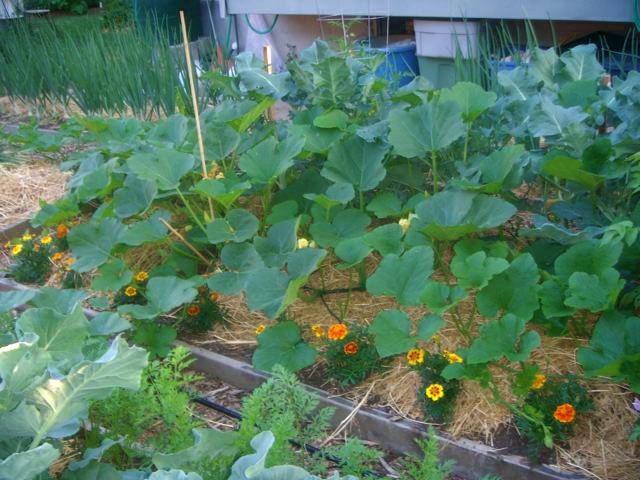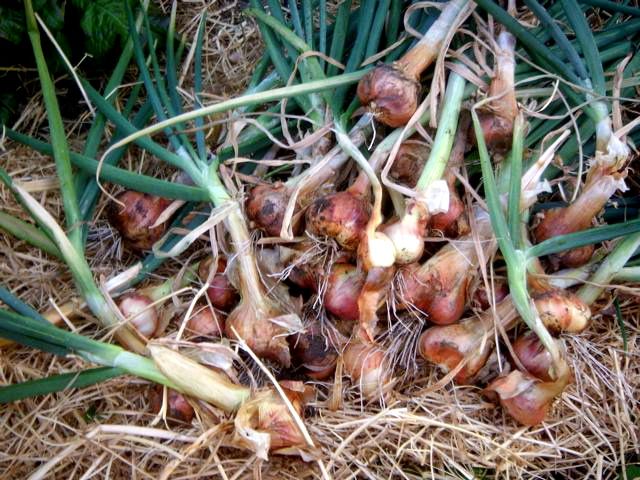
pumpkin plants, l
(post, Harriet Fasenfest)
With a little space between classes and the summer planting done, I’ve been granted time to ponder and write. I am still tethered (by choice) to the beauty and vegetal madness of the place, and soon I will plant my winter garden, but at the moment I am thinking about the harvest and a new field in backyard farming: side-dish gardening. Growing for side dishes is a particular niche. And not just any kind of side dish. I’m talking about keepers, stuff that holds up well during the dark days ahead. Sure, anyone can slice a tomato and lather it with olive oil and basil to pop, fresh, in the mouth (and to be sure, that is a great moment in the garden). But I’ve got my squirrel hat on and am thinking about tomorrow. Case in point are my towering romano green beans. They have become favorites. They are good eating freshly steamed in season, but I also like to cook them up with onions, tomatoes, garlic, oregano, and basil. It’s a no-fuss, no-exact-recipe thing that always comes out good 'cause of the garlic and herbs. I freeze that stew for sometime in winter when it will make a nice side dish. Romano green beans don’t get mushy when frozen like some do. They are flat and broad and keep their texture and flavor. I learned that from an older woman at the market. I asked if she liked them. She told me the drill in the oral tradition. [%image reference-image float=left width=400 caption="Shallots waiting to be cured."] I grow food for a lot of side dishes and actually plan my garden by it. This year there are copra onions, shallots, and garlic to make everything tastier throughout the seasons. I’m seeing how well I can cure and store them and how long what I grow will last. I think they are power players in the garden; they don’t take up too much space and require a lot of hard work in the kitchen. Some folks like to grow leeks for that allium hit in winter, and that is fine; I grow them, too. But I like my yellow onions, so I’m giving that a try. I also grow a lot of butternut squash, because they will sit in an outdoor space for a long time providing that it doesn't freeze before you harvest. If they do “catch a cold,” they will get a kind of glassiness to the outer skin, which lets you know they are an “eat me now or soon” kind of creature. The ones that don’t get a frost (and one easy freeze won’t hurt) will last you until April if they are cured right. Something about letting it sit in a warm room (75 degrees, I’m thinking) for a week or so to cure, or harden, the skin is important. (For that specific sort of info, I go to the Oregon State University extension site to read one of the publications on food preservation that relates to storage. There is lots of helpful information available there, so you should take a look.) But butternut squash are so good in so many ways that I can hardly write about them without longing. So few seeds and so much “meat” and so sweet and fluffy when whipped or baked or roasted or diced in soups or stews. Get the picture? So butternut squash, a sugar-pie pumpkin or two (gotta have the pie for the feast), and potatoes — russets and yellow banana. Well, the yellow banana potatoes are for late summer or sooner, but the russets can go some distance. They too must be cured to harden their skins, but properly done, they will last into late winter. The ones that are not as obliging will simply be eaten sooner. And remember, potatoes should not have a green cast to them. Evidently there is something toxic to it. Give them to the compost gods. Of course, there are my perennial bloomers: my fruit and berries. That big and illustrious Bartlett pear tree (the one that started me on my food-preservation journey) produces enough pears to make sheets and sheets of upside-down pear-gingerbread cake for New Year's Day. I just can the pears in season and wait till the time approaches. They are perfect for holding up to the glazing and cooking in the cake and are wonderfully flavorful. Lucky me, lucky everyone who eats some. I guess that’s the point of New Year's. I will leave it to you to find any good gingerbread recipe and follow any good recipe for upside-down cake. It’s pretty much the same concept repeated in the author’s fancy, so just get fancy yourself. Serve it with sour cream and prepare to get spanked. But then, you can also store pears a bit. Not the ripe ones, of course, but the ones that are still hard (the way they should be when you pick them). Pears don’t ripen on the tree but rather at room temperature. You can hold off that process by keeping them cold. I guess if you had extra fridge space you might make a go of it, but I don’t, at least not for the mass of pears I get. And even if I get an extra fridge, which I might, pears require a lower, more controlled, temperature and humidity than I can guarantee around my home. The fruit companies have got it down, which is why they do it and why they can put out pears throughout the year. I guess I’ll stick to canning them, but they also make great pear butter and pear sauce. Oh my, pear sauce with our latkes last year was mighty tasty. Of course the husband thought it was “funny-tasting applesauce,” so there you go. Some subtleties of experience get lost around here. There are the herbs (dried) and sauces (ketchup and barbecue). And speaking of sauces is like speaking about tomatoes. OMG, do I have lots of tomatoes. I grow mostly plum tomatoes 'cause I like them for canning and making sauce. Mostly I blanch, seed, and dice them before canning. They turn into everything a canned tomato ever was used for — soups, sauces, stews, salsa, etc. Along with my cured garlic, they are the thing to reach for day in and day out. And I can lots. [%image "pumpkin plants" float=left width=400 caption="Sugar-pie pumpkin plants."] I have said it before and I will say it again: If you do nothing else in the preserving kitchen, do tomatoes. Of course, growing them will encourage the effort, since here in the Northwest the babies come on with a fury in late August and early September. Consider it a survival skill — you will not have to stare down the endlessly ripening batch with despair. Just let them do their bountiful part and you do yours. Even so, there are always the green ones that won’t ripen — this is Oregon, after all. But they, too, can be stored for later use. Just wrap them individually in newsprint and store them outside. Keep an eye out for mushy ones that can slime the whole load. I find I can bring them in as I need them to finish ripening in the house. They will not be as tasty as vine-ripened, but they will work. But not all green tomatoes want to be stored. Some want to find their way into jams or chutneys. In fact, lots of late summer foods can find a home in chutney. I have a basement full of green tomato, fig, and apple chutney, which I love and don’t. I love it 'cause I can use it in a pinch by pouring it in with my braising pork or chicken. I use it as a glaze and as a side with roasted poultry or as a condiment with lentils, rice, and yogurt. I act like I love it so that my family will still their resistance; somehow they have learned to follow my lead or else they know what I will say — something about starving children which is so much more about fact than cautionary verse these days. It does break my heart and goodwill sometimes. But the crowning glory to green tomatoes is the fried-green-tomato parmigiana I made last year. I made it in batches large enough to feed four and put them in aluminum roasting pans for freezing. They made great gifts for friends with a whole lot less time (or different time) than me. I just put down the cooking instructions and gave them away during the holidays. I called it a "gift of time," which, as all of us know, can be pretty precious. So here is the recipe in the oral tradition. I gotta assume you know some of this stuff, so I’ll be brief. I’m sure you’ll get the picture. The tangy bite of green tomato served as something so much more than a way to get rid of the furious, if under-ripened, bounty. 1. A bunch of green tomatoes — what you've got. 2. Fry them up as for eggplant parmigiana. Got fresh herbs, great. Got stale bread, cornmeal — yahoo. Got some farm-fresh eggs? Now you're in business. 3. Make a béchamel sauce. Now that’s a switch, but you know how. A little nutmeg in it is nice. 4. Make a tomato sauce. You know that as well. 5. Some cheeses as you like. 6. Layer: Fried green tomatoes, béchamel, cheese, tomato sauce, again till you reach the top. I end with slices of mozzarella and provolone. Freeze in aluminum pans to give away or Pyrex to get back (or as another gift). Masking-tape instructions for cooking: one half-hour in a preheated 350-degree oven with lid on, one half-hour with lid off. Delicious. Particularly since the recipient doesn't have to cook and you get rid of your green tomatoes.

pumpkin plants, l

reference-image, l